Advertiser Disclosure: Eye of the Flyer, a division of Chatterbox Entertainment, Inc., is part of an affiliate sales network and and may earn compensation when a customer clicks on a link, when an application is approved, or when an account is opened. This relationship may impact how and where links appear on this site. This site does not include all financial companies or all available financial offers. Opinions, reviews, analyses & recommendations are the author’s alone, and have not been reviewed, endorsed, or approved by any of these entities. Some links on this page are affiliate or referral links. We may receive a commission or referral bonus for purchases or successful applications made during shopping sessions or signups initiated from clicking those links.

Have you ever got a warning on your phone that the power incoming when plugged in is less that the power being used? It happened to me recently on a Delta jet and it got me thinking just how much power i.e. volts and amps do the different USB ports we plug into when we travel really provide? Notice what “Wired.com” tells us:
“Ultimately, it’s really the amperage that determines how fast a charger will supply power to your device. If you want quicker charging, look for a wall or car charger that delivers 2100 mA of current at 5 volts (or whatever voltage the device you’re trying to charge is specced at).”
First some baselines and some methodology these numbers and tests are from my phone. For example, the max I am drawing with my Samsung Note 4 from home and plugged into power is what you see above.
The same goes from my sweet mega battery brick. Both wall and battery should push 2 amps but clearly my phone does not pull that full amount. The point is that I consider the above numbers “full” power and the other results will be based on these baseline numbers.
I thought I would first test stuff around my house with this simple DROK 300043 USB 2.0 Digital Multimeter, Ammeter Voltmeter Capacitance and Watt Meter on devices like my computer USB power port. I rarely use it to provide power as it did seem slow and now I know why as both the voltage and amps are ~36% of the wall power.
Next on to my laptop USB port as I do often plug into this when I am tethering my Sprint PCS internet service to my laptop. While the voltage is a bit higher the same poor amps are provided. On to tests on the road.
How about some tests at the brand new shiny Delta B Sky Club. There are power ports just all over the place and the in-seat ones as well as the pop-up (or out) ones in the tables are providing solid results. Nice.
Now over to the international concourse and the iconic F club with the Sky Club. Here you will see all over the place power “towers” that have both USB and standard power. While the ports in the tables between the seats was solid notice the lower yield from the towers.
There are also power towers at most of the Delta gates in various hubs. So how do they stack up? Notice the disappointing results from my test in Salt Lake yesterday. Ugg. Next let’s move on to flights as this is really what sparked this whole test effort.
The above is my USB to standard wall outlet power adapter. I was expecting this to provide good power and it did. Not quite what I got at home but respectable results. What about the USB in the seat back on a Delta international A330?
OUCH! – Again we are talking about 36% of wall power! And this I can imagine is why I received the warning from my phone that the needed amperage was not adequate to keep up. Let’s look at a few more.
Again we see only marginally better performance in Delta One on the A330 I flew to Hong Kong and back recently. Thankfully the flight was some 14 hours long so even slow charging got me to 100% after a while.
Last up we have an A320 that has just been reconfigured with the new oversized overhead bins. Again, less than exciting results from the USB ports.
So what should you take away from all of these many tests? Clearly just how much “juice” you get will depend on where you plug in – that is, all USB power sources are not created equal and you may not be charging as fast as you think. Next, if at all possible, you will yield the best results using a wall to USB power adapter or a good output battery brick to charge your phone.
You may have on your own already come to the exact same conclusions from trial and error but at least now you have more data points to show you were spot on with your assumptions.
Before I sign off for the day I am no expert in electronics but thought this post would be useful. If you such an expert feel free to comment but please be nice 😉 – René
Advertiser Disclosure: Eye of the Flyer, a division of Chatterbox Entertainment, Inc., is part of an affiliate sales network and and may earn compensation when a customer clicks on a link, when an application is approved, or when an account is opened. This relationship may impact how and where links appear on this site. This site does not include all financial companies or all available financial offers. Opinions, reviews, analyses & recommendations are the author’s alone, and have not been reviewed, endorsed, or approved by any of these entities. Some links on this page are affiliate or referral links. We may receive a commission or referral bonus for purchases or successful applications made during shopping sessions or signups initiated from clicking those links.


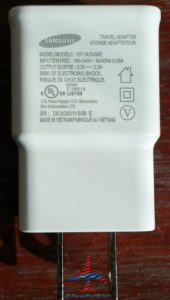
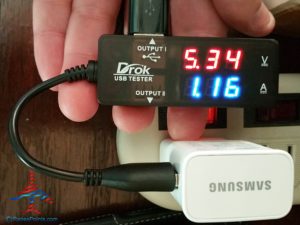
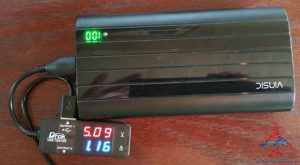
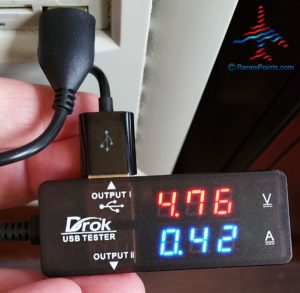

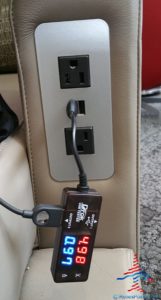
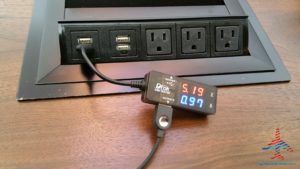
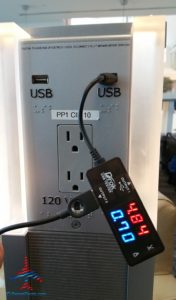
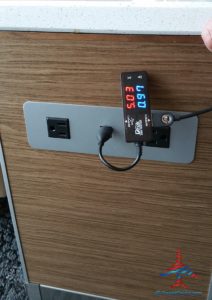

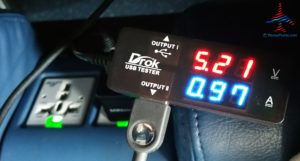
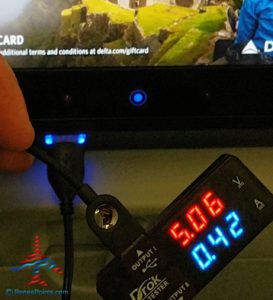
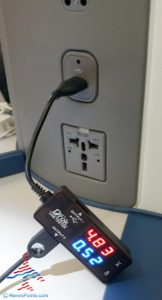
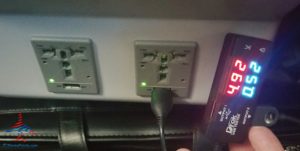








You, sir, are a huge nerd. But I’m glad you are, and I’m glad you share your nerdiness with the rest of us so we can learn. Happy travels.
very good nerd out session Rene, considering a usb-c (newer android devices) require 2-3amps to get a decent charge going this would, in fact, take forever to charge via USB. my tablet, for example, would take 9 hrs if I didn’t use it to get this charge ill start using the power adapters vs the USB port from now on thanks for the great data.
Thanks for the Phase 1 test, Renè. Next, please take a single location (e.g. boarding area tower), and conduct a series of tests to see the what the impact of having additional devices charging concurrently is.
Cheers!
First of all, if they truly have a Galaxy Note 4, it has qualcomm quick charge capability. Which means when using the samsung provided charger, it will charge @ 12V and a probably around 1.5A which would be 18W. If you were to use that same phone on modern 5V charger capable of delivering 3A it would easily pull 2-3A (10-15W) depending on charge level.
@Jim – Thanks for your first ever comment on the blog (I edited out your nasty personal attacks btw).
.
Next, you may not be aware I have a ZeroLemon battery on my phone so fast charge is turned off. Either way, I made it clear what the base line was with wall power and you can use that to compare the results of wall vs USB at the locations I tested.
Maybe try the same test with a high capacity (Anker or Aukey) wall charger plugged into the adjacent AC wall jacks. Not as convenient, but I find it allows me to get the full charge I need in less time.
@Frank – Always find wall type outlets better but wanted to test USB performance
These data points explain a lot. It’s not just Delta of course, I’ve experienced very slow charging with other airlines. In one case my phone was not completely charged after plugged into a USB port for over 4 hours. Thanks for your diligent efforts to collect the information and share it.
I remember USB being limited to 500mA once upon a time. Obviously devices these days need a lot more than this to charge within any real length of time. Surprising that those USB ports aren’t capable of more.
On the bright side, I do have a TeamBoardLast success story from ATL-SLC on this Saturday. Guy missed a connection and myself being #12 jumped to #1 as others boarded. Gate agent was beyond helpful with this and walked on a bit late, but got my 01B seat.
what about the 110v power on the new a320(ow)? i just flew slc-ewr and pluged in my asus laptop wall charger and it did not work. computer ran on battery power only. it fell out and i plugged it back in, still nothing. i pulled it for about an hour and decided to try it one more time. This time it worked and recharged the battery while i watched a delta studio movie. maybe i just didn’t have a solid connection at first?
@E – I have run into this years ago. What I do is just pop the battery out and then you can run on AC power. Not great but works. Try it next time.
It’s also wise to always use a USB condom. This little device ensures that the data pins are not connected. The USB power on the IFE especially is coming from a Linux computer so you don’t want to have the data pins active. Compromises do exist that could cause you problems. One of the main reasons I usually never use USB power, I just don’t know enough about where it is connected on the other side.
If your device is fully charged, does the device still show the same amps? Typically as a battery finishes it’s charge above 70-80% it doesn’t keep charging at the faster amp rate. Your reader may not present accurate results unless the battery is about 50% or less.
@Matthew – As mentioned, I have an extended high capacity battery. It only charges at the slow standard rate no matter what the drain percentage.